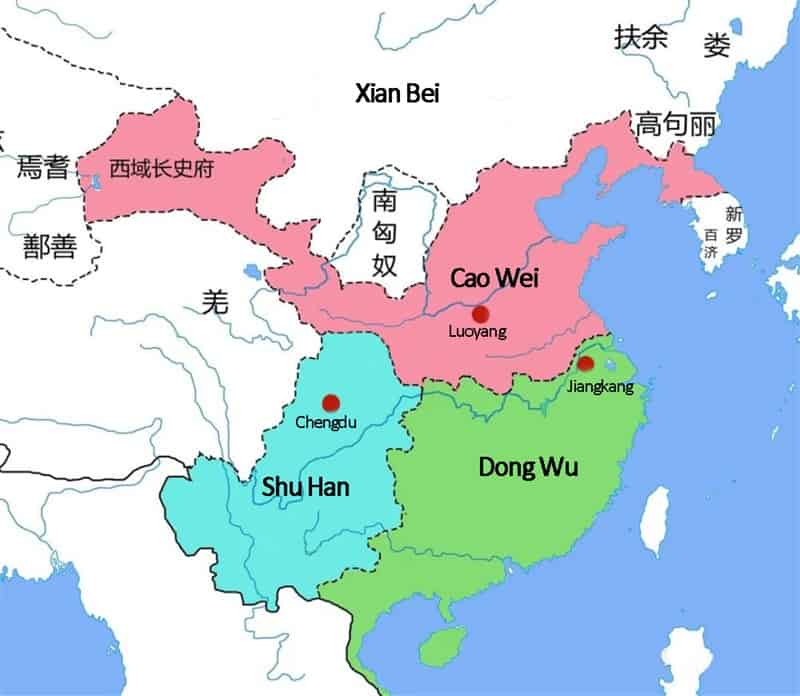Three Kingdoms Period – History, Stratagem and Story
The Three Kingdoms is a short period with only 60 years after Han dynasty, but it is one of the most popular dynasties among Chinese people, nothing less than the most powerful and flourishing Han Dynasty, Tang Dynasty and Qing Dynasty. An important reason is because of the widespread novel The Romance of the Three Kingdoms by Luo Guangzhong, one of China’s four most important pieces of literature. Chinese people learn historical allusions, ancient wars and stratagems from this novel and different kinds of artistic expression forms. Another way to make the Three Kingdoms so widely known around the world is the computer game, Three Kingdoms Total War. Here, let’s talk something about the history, stratagems and stories of the Three Kingdom Period.
History of the Three Kingdoms Period
At the end of Han Dynasty, the country was divided into three regimes (kingdoms) headed by leaders Cao Cao (曹操) who controlled the north of the Yangtze River known as Cao Wei (曹魏); Liu Bei (刘备) who controlled southwestern region known as Shu Han (蜀汉) and Sun Quan (孙权) who controlled the southeastern region known as Dong Wu (东吴). The Three Kingdoms period is one of the bloodiest periods in history of China, in which wars had never stopped.Establishment of three kingdoms
By the end of the 2nd century, the Dong (Eastern) Han Empire was disintegrating into chaos. Its last emperor, Liu Xie had become a mere puppet under the control of Dong Zhuo (董卓) and later Cao Cao. In 201 AD, Cao Cao defeated the strongest warlord Yuan Shao (袁绍) in the Battle of Guandu (官渡之战) and gradually unified the northern area of China. But when he want to expand his power to the south of Yangtze River, he was defeated by the allied forces of Liu Bei and Sun Quan in the Battle of Chibi (赤壁之战) and had to withdrew to central China.The order of the establishment of three kingdoms was Cao Wei, Shu Han and Dong Wu. In the year of 220, Cao Pi, son of Cao Cao forced Emperor Xian, last ruler of the Han Dynasty, to abdicate and proclaimed himself Emperor of Cao Wei. Later in 221, Liu Bei set up Shu Han at Chengdu and in 222, Sun Quan set up Dong Wu at Jianye (Nanjing). Thus the country was divided into three parts, historically called Three Kingdoms Period.
Introduction of Three Kingdoms
Among three kingdoms, Cao Wei is the strongest, no matter in territory, population and economy. The area it controlled had been China’s political center for thousands of years. It finally defeated Shu Han and soon after itself changed to Jin Dynasty, it forced Dong Wu to surrender.Dong Wu controlled the Yangtze delta and its south mountainous area. It had good agriculture economy and powerful navy, but it suffered from internal power struggle and infesting by tribes in mountain areas.
Shu Han Kingdom centered Chengdu. Though Chengdu plain is a fertile land, the area around it is the most mountainous area in China. There is a saying that the way to Shu is harder than scaling the blue sky. With the least population and weak economy, Shu Han was the most aggressive kingdom. Between 228 and 234, the Shu regent Zhuge Liang (诸葛亮), launched a series of five military campaigns (known as the "Northern Expeditions (北伐)". After the death of Zhuge Liang, General Jiang Wei (姜维) followed up on his legacy by launching another 11 military campaigns against Wei. To expand Shu’s territory for more and better resources is the main reason, but the ultimate goal of these campaigns was to restore the Han dynasty, as Liu Bei claimed that as part of the royal family, he had legitimate right to succession of Han Dynasty.
End of three kingdoms
End of Cao Wei and the establishment of Jin Dynasty - Sima Yi (司马懿), an important military general and politician in the Three Kingdoms period, succeeded in both handling domestic and military affairs of Cao Wei soon after its founding. In 249, after carefully planning and building up support, he eliminated all his political opponents and state power increasingly rest in the hands of the Sima clan. On 4 February 266, Sima Yi's grandson, Sima Yan, forced Cao Huan, the last emperor of Cao Wei, to abdicate in his favor to establish Jin dynasty.The Fall of Shu Han– Due to rounds of waging war against Cao Wei, Shu Han was growing weak. In the winter of 262, Sima Zhao, Cao Wei’s new regent launched the war to invade Shu. Shu Han’s last emperor, Liu Chan surrendered at Chengdu in 263. Shu Han became the first among three Kingdoms fell first.
End of Dong Wu – With the conquest of Shu Han, Wei became stronger. And finally, Sima Yan successfully forced Cao Huan to abdicate and established Jin Dynasty. In the year of 279, Jin invaded Dong Wu and the last emperor of Wu, Sun Hao surrendered on May, 1st, 280. Thus the Three Kingdoms Period finished.
Fact of the Three Kingdoms Period
| State | Cao Wei | Dong Wu | Shu Han |
|---|---|---|---|
| Time Period | Dec. 11, 220 – Feb. 8, 266 | May 23, 222 – May. 1, 280 | May. 15, 221 - 263 |
| Population | Luoyang | Jian Ye (Nanjing) | Chengdu |
| Population | 4.43 million | 2.3 million | 0.94 million |
| First Emperor | Cao Pi | Sun Quan | Liu Bei |
| Last Emperor | Cao Huan | Sun Hao | Liu Chan |
Map of the Three Kingdoms

How historically accurate is the novel Romance of the Three Kingdoms (三国演义)?
As one of one of the four great Chinese classic literature masterpieces, Romance of the Three Kingdoms was written in late Yuan Dynasty and early Ming Dynasty by Luo Guanzhong (罗贯中). The novel is based on a Chinese historical text, Records of the Three Kingdoms (三国志) by Chen Shou (陈寿). The story – part historical and part fictional - has a total of 800,000 words and nearly a thousand dramatic characters in 120 chapters. Most of events and characters in the novel are historically real, but the book intermingled fact with fiction perfectly.Famous battles in Three Kingdoms Period
The history of Three Kingdoms is in fact a history of wars. In the end of the 2nd century, the East Han Empire was disintegrating into chaos and brutal localized wars, rebellions and uprisings were rife. Later, with the emperor’s power fell into warlords like Dong Zhuo and Cao Cao, wars among warlords had never stopped till the Three Kingdoms finally established. Wars among three kingdoms, especially wars between Cao Wei and Shu Han were from the beginning to the end. Here are some famous battles in this historical period.| Battle | Time | Battlefield | Winner | Loser | Historical Impacts |
|---|---|---|---|---|---|
| Battle of Guandu (官渡之战) | 200 AD | Guandu (官渡; northeast of present-day Zhongmu County, Henan) | Cao Cao | Yuan Shao | The victory made Cao Cao the dominant power in northern China, and leading to the establishment of the state of Cao Wei. |
| Battle of Red Cliffs (赤壁之战) | 208–209 AD | Puxi County, Chibi, HuBei Province | Allied forces of Sun Quan and Liu Bei | Cao Cao | Cao Cao fails to conquer lands south of the Yangtze River. Sun Quan and Liu Bei consolidated their rule and finally form the Three Kingdoms. |
| Battle of Yiling (夷陵之战) | 221-222 AD | Yidu County, Yichang, Hubei Province | Dong Wu | Shu Han | The decisive victory over Shu halted the Shu’s invasion and formed a new balance among three kingdoms. |
Most famous figures in Three Kingdoms Period
Cao Cao, courtesy name Mengde (孟德), (155 A.D. - 220 A.D.) - was the most powerful warlords in late Eastern Han Dynasty and laid the foundations for what was to become the state of Cao Wei Kingdom, the strongest one among the three kingdoms. He was also a Chinese poet.Liu Bei, courtesy name Xuande (玄德), (161 A.D. - 223 A.D.) - was born in a declining family with Han Royal descent. He later became a warlord in the late Eastern Han dynasty. After years of war with other warlords, especially Cao Cao, he founded the Shu Han Kingdom.
Sun Quan, courtesy name Zhongmou (仲謀) , (182 A.D. - 252 A.D.) - inherited control of the warlord regime established by his elder brother, Sun Ce. In 222, he set up Dong Wu Kingdom and became the first emperor.
Zhuge Liang, courtesy name Kongming (孔明) ,(181 A.D. - 234 A.D.) - was a famous ancient Chinese statesman and military strategist. As the military counselor, he assisted Liu Bei in founding Shu Han Kingdom and he was worked as prime minister and later regent of the state. He is recognized as one of the most accomplished strategist in ancient China.
Guan Yu, courtesy name Yunchang (云长), ( ? - 220 A.D.) - was an ancient Chinese military general I the late Eastern Han Dynasty. Along with Zhang Fei, he shared a brotherly relationship with Liu Bei and assisted him in established Shu Han Kingdom. He have been worshipped by Chinese people because of his loyalty and righteousness. In religious devotion he is reverentially called the "Emperor Guan" (Guān Dì) or "Lord Guan" (Guān Gōng). He is a deity worshipped in Chinese folk religion, popular Confucianism, Taoism, and Chinese Buddhism, and small shrines to him are almost ubiquitous in traditional Chinese shops and restaurants.
Zhang Fei, courtesy name Yide (翼德), ( ? - 221 A.D.) – was a military general serving under the warlord Liu Bei. He and Guan Yu shared a brotherly relationship with Liu Bei, and assisted him in founding Shu Han Kingdom. Both Guan Yu and Zhang Fei were praised as mighty warriors capable of fighting thousands of enemies. However, Zhang Fei was brutal and heartless, which resulted in his death.
Sima Yi, courtesy name Zhongda (仲达), (179 A.D. - 251 A.D.) - was an ancient Chinese military general, politician, and regent of the Cao Wei Kingdom. He is perhaps best known for defending Wei from a series of invasions from Shu Han. Before he died in 251, Sima clan actually capture the state power, which led to the establishment of the Jin Dynasty.


